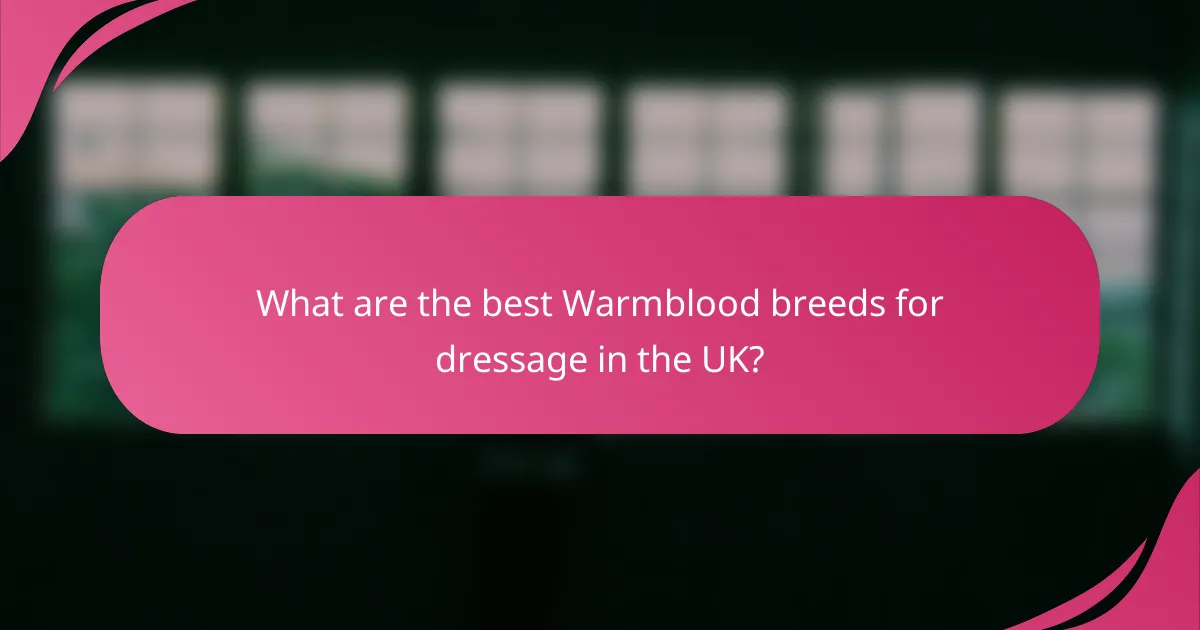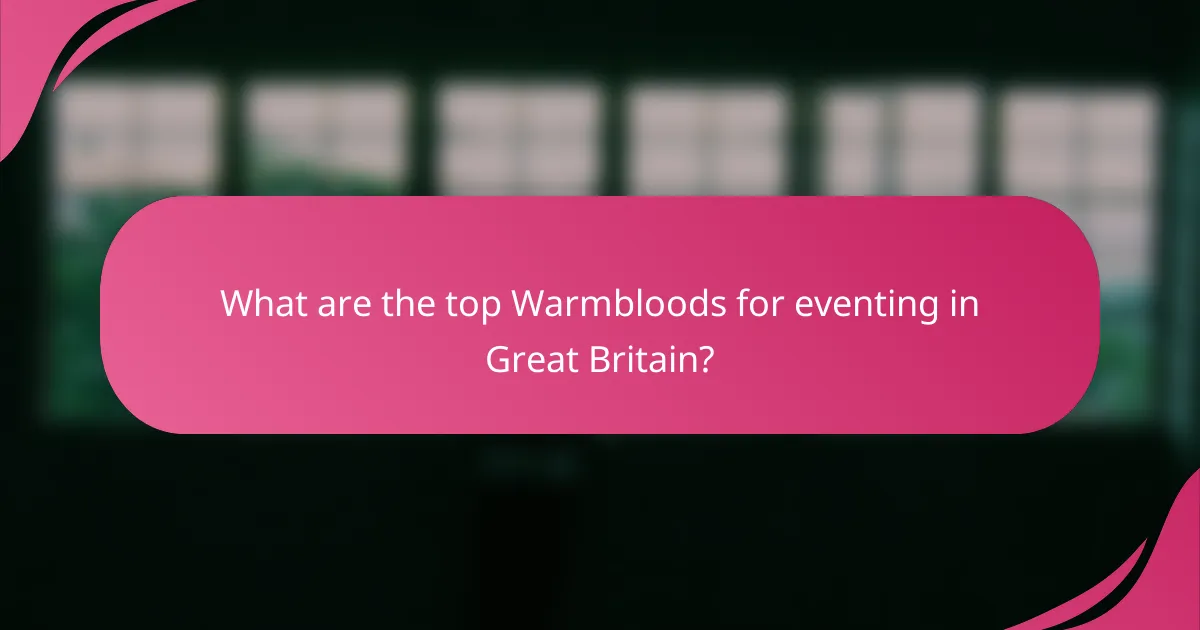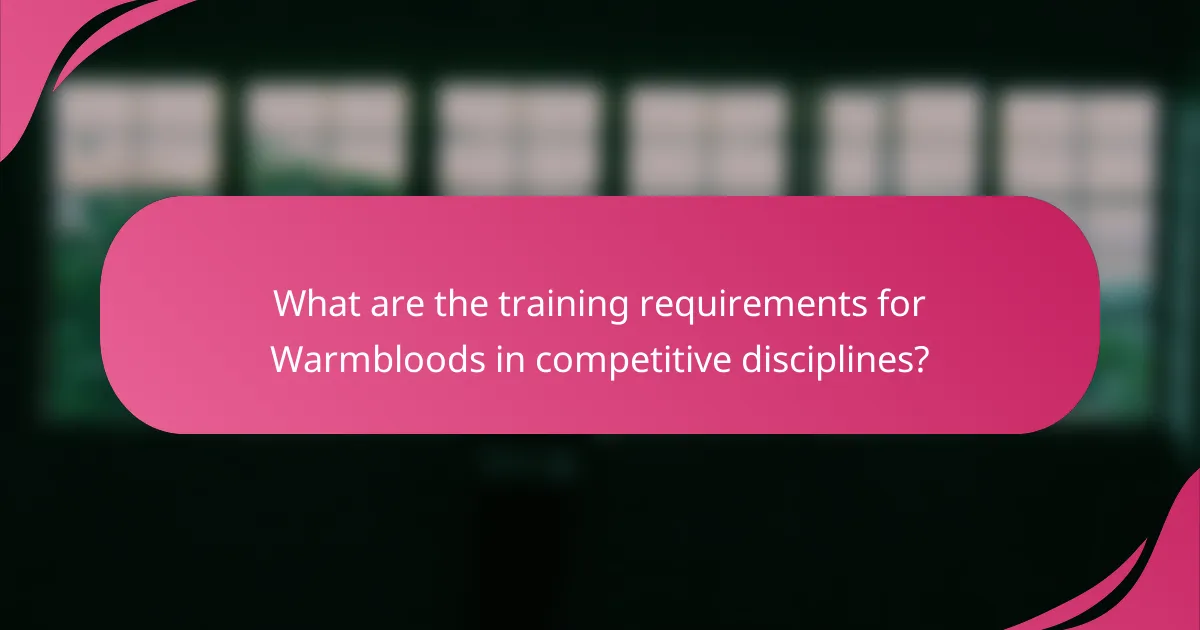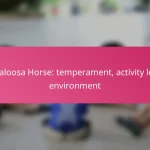Warmblood horses are highly regarded in equestrian sports such as dressage, show jumping, and eventing due to their exceptional athleticism and trainability. Breeds like the Hanoverian and Dutch Warmblood excel in dressage, while the Trakehner and Holsteiner are top choices for eventing. Selecting the right Warmblood involves considering their physical capabilities and temperament to ensure success in competitive settings.

What are the best Warmblood breeds for dressage in the UK?
The best Warmblood breeds for dressage in the UK include the Hanoverian, Dutch Warmblood, and Oldenburg. These breeds are renowned for their athleticism, trainability, and strong movement, making them ideal choices for competitive dressage.
Hanoverian
The Hanoverian breed is highly regarded in the dressage world for its powerful build and exceptional temperament. Known for their impressive gaits and willingness to work, Hanoverians often excel in both amateur and professional competitions.
When selecting a Hanoverian for dressage, look for horses with strong hindquarters and good elasticity in their movements. These traits contribute to their ability to perform advanced dressage movements with grace and precision.
Dutch Warmblood
Dutch Warmbloods are celebrated for their versatility and athleticism, making them a popular choice for dressage riders. They typically possess a strong, balanced frame and are known for their expressive gaits, which are essential for scoring well in competitions.
Consider the Dutch Warmblood’s pedigree when purchasing, as bloodlines can significantly influence performance. Horses from successful dressage lines often exhibit superior trainability and competitive spirit.
Oldenburg
The Oldenburg breed combines strength and elegance, making it an excellent option for dressage enthusiasts. With their solid build and impressive movement, Oldenburgs are often seen in top dressage arenas across the UK.
When evaluating an Oldenburg for dressage, pay attention to their conformation and movement quality. A horse with a good shoulder angle and strong hind leg will typically perform better in dressage tests.

How to choose a Warmblood for show jumping?
Choosing a Warmblood for show jumping involves assessing the horse’s physical capabilities, temperament, and training background. Prioritizing these factors ensures you select a horse that can excel in competitive environments.
Evaluate jumping ability
Jumping ability is crucial when selecting a Warmblood for show jumping. Look for a horse with a strong, athletic build, as well as a natural talent for jumping, which includes a good bascule and scope. Observing the horse in action over various jumps can provide insight into its technique and confidence.
Consider the horse’s experience with different types of jumps, including verticals, oxers, and combinations. A horse that has successfully navigated these obstacles in training or competitions is more likely to perform well in a show setting.
Consider temperament
Temperament plays a significant role in a Warmblood’s performance in show jumping. A horse that is calm, focused, and willing to work will be easier to train and compete with. Look for a horse that displays a positive attitude and is responsive to cues.
Be cautious of overly nervous or aggressive horses, as these traits can hinder performance and make training more challenging. A balanced temperament can greatly enhance the partnership between horse and rider.
Assess training history
The training history of a Warmblood is essential in determining its readiness for show jumping. A horse that has undergone consistent and quality training will likely have a better foundation in jumping techniques and discipline. Review any competition records or training logs to gauge its experience level.
Additionally, consider the quality of the training the horse has received. Horses trained by reputable trainers or those with successful competition backgrounds may have an advantage in terms of skills and adaptability in the show ring.

What are the top Warmbloods for eventing in Great Britain?
The top Warmbloods for eventing in Great Britain include breeds known for their versatility, athleticism, and temperament. Key contenders are the Trakehner, Holsteiner, and Westphalian, each offering unique strengths that cater to the demands of eventing.
Trakehner
The Trakehner is celebrated for its agility and endurance, making it a popular choice for eventing. This breed typically possesses a refined build, which contributes to its ability to excel in dressage and jumping phases.
When selecting a Trakehner for eventing, consider their training and temperament. A well-trained Trakehner can be a responsive partner, but potential buyers should ensure they have a solid foundation in both dressage and jumping skills.
Holsteiner
Holsteiners are renowned for their powerful jumping ability and strong build, which are advantageous in the cross-country phase of eventing. Their athleticism allows them to tackle various obstacles with confidence.
For eventing, look for Holsteiners with a good balance of speed and stamina. They often require consistent training to harness their energy effectively, so prospective owners should be prepared for a commitment to their development.
Westphalian
The Westphalian breed is known for its versatility and strong work ethic, making it suitable for all three phases of eventing. They typically exhibit a calm demeanor, which can be beneficial in high-pressure situations.
When considering a Westphalian for eventing, evaluate their pedigree and previous competition experience. A horse with a solid background in eventing will likely adapt well to the demands of the sport, providing a reliable partner for riders.

What are the training requirements for Warmbloods in competitive disciplines?
Warmbloods require a structured training regimen tailored to their competitive disciplines, including dressage, show jumping, and eventing. Consistent practice, conditioning, and skill development are essential for success in these areas.
Regular dressage training
Dressage training for Warmbloods focuses on developing their balance, flexibility, and responsiveness to the rider’s aids. Sessions typically include exercises that enhance movement precision, such as lateral work, transitions, and various gaits. Regular practice, ideally several times a week, helps establish a strong foundation for competition.
Incorporating movements like shoulder-in, half-pass, and flying changes can significantly improve a horse’s performance. Trainers should aim for a mix of short, focused sessions and longer, more comprehensive workouts to maintain the horse’s interest and stamina.
Jumping practice sessions
Jumping practice is crucial for Warmbloods competing in show jumping and eventing. These sessions should include a variety of jumps, such as verticals, oxers, and combinations, to build confidence and technique. Regular exposure to different courses and heights helps prepare the horse for competition scenarios.
It’s beneficial to include grid work in training, as it teaches the horse to judge distances and improve their jumping form. Practicing at least once or twice a week can help maintain the horse’s skills and readiness for events.
Conditioning and fitness routines
Conditioning and fitness routines are vital for Warmbloods to perform at their best in competitive disciplines. These routines should incorporate aerobic exercises, strength training, and flexibility work. Activities like trail riding, lunging, and long lining can enhance overall fitness and stamina.
Setting a consistent schedule that includes conditioning sessions several times a week will help the horse build endurance. Monitoring the horse’s weight and energy levels is essential to adjust the training intensity and prevent overexertion.

What are the costs associated with owning a Warmblood horse?
Owning a Warmblood horse involves several costs, including the initial purchase price, ongoing care expenses, and training and competition fees. Understanding these financial commitments is essential for prospective owners to ensure they can provide for their horse’s needs.
Purchase price
The purchase price of a Warmblood horse can vary widely based on factors such as age, training level, and pedigree. Generally, prices can range from several thousand to tens of thousands of dollars, with top-quality horses often exceeding this range.
When considering a purchase, it’s crucial to factor in not just the initial cost but also the horse’s potential resale value and any additional costs for transportation or pre-purchase veterinary exams.
Ongoing care expenses
Ongoing care expenses for a Warmblood horse typically include feed, veterinary care, farrier services, and insurance. Monthly costs can range from a few hundred to over a thousand dollars, depending on the horse’s health and the level of care provided.
Regular veterinary check-ups, vaccinations, and dental care are essential to maintain the horse’s health. Additionally, farrier services for hoof care are necessary every 6 to 8 weeks, which can add significantly to the overall monthly expenses.
Training and competition fees
Training and competition fees can be substantial for Warmblood horses, especially for those involved in dressage, show jumping, or eventing. Training costs may include lessons, boarding at a training facility, and the trainer’s fees, which can total several hundred dollars per month.
Competition fees, including entry fees, travel expenses, and equipment, can also accumulate quickly. Owners should budget for these costs, as participating in events is often crucial for a horse’s development and marketability.


